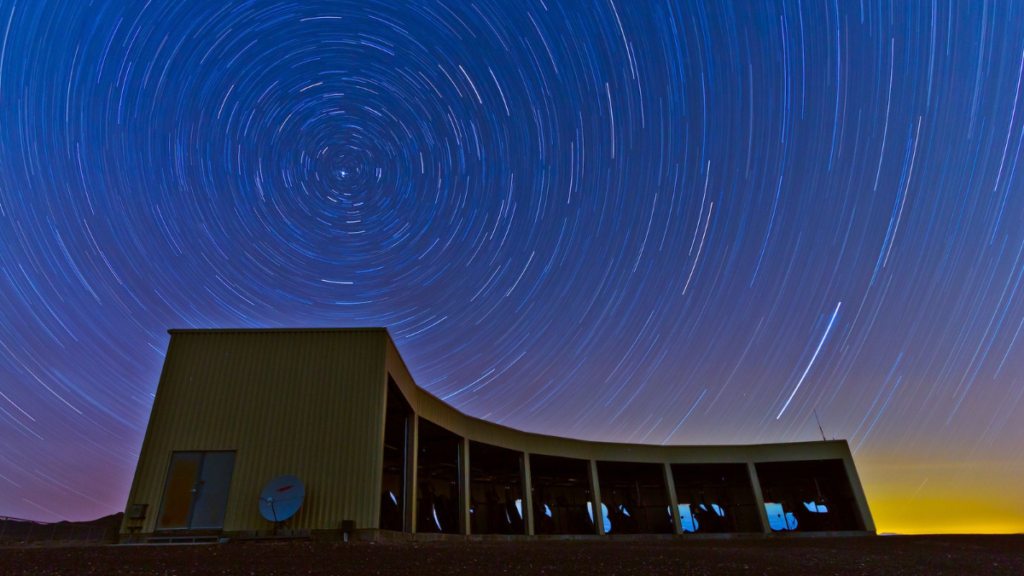In a groundbreaking discovery, space scientists have stumbled upon a Mysterious Cosmic Ray—an ultra-high-energy particle that has journeyed to Earth from a realm beyond our Milky Way galaxy. Unveiled by the Telescope Array Collaboration, a cosmic ray observatory nestled in Utah’s West Desert, this rare subatomic particle, dubbed the “Amaterasu particle,” challenges our understanding of the origins and nature of cosmic rays. The discovery, made by the Telescope Array Collaboration, a cosmic ray observatory in Utah’s West Desert, challenges our understanding of the origins and nature of cosmic rays. The Amaterasu particle, named after the sun goddess in Japanese mythology, has an energy level of approximately 244 exa-electron volts, surpassing the energy levels of even the “Oh-My-God” particle discovered in 1991. The Telescope Array, a scientific collaboration between the University of Utah and the University of Tokyo, has been instrumental in uncovering these cosmic puzzles by capturing cascading particles resulting from high-energy cosmic ray interactions with Earth’s atmosphere. The enigmatic journey of the Amaterasu particle from the Local Void, a cosmic void adjacent to our galaxy, raises profound questions, as visible telescopes fail to unveil significant and violent events in the particles’ trajectories. An expansion to the Telescope Array, featuring an additional 500 detectors, aims to broaden the scope of observation to 2,900 square kilometers, providing new insights into cosmic rays and their elusive sources.
Cosmic Rays: Unraveling the Invisible Torrents
Cosmic rays, composed of charged particles, incessantly traverse the vast expanse of space, showering down upon Earth. While low-energy cosmic rays, often stemming from our sun, are commonplace, their ultra-high-energy counterparts remain elusive and extraordinary. These energetic entities, believed to originate from other galaxies and extragalactic sources, hold the key to unraveling the most enigmatic phenomena in the universe, from black holes to gamma-ray bursts.
The Amaterasu Particle: An Extraordinary Discovery
The Mysterious Cosmic Ray, named after the sun goddess in Japanese mythology, was detected by the Telescope Array on May 27, 2021. This observatory, operational since 2008, comprises 507 ping-pong table-sized surface detectors spread across a staggering 700 square kilometers. Despite the array’s prolonged existence, the Amaterasu particle stands as a singular revelation, surpassing the energy levels of even the famed “Oh-My-God” particle discovered in 1991.
Unraveling the Energy Spectrum
To comprehend the scale of this cosmic anomaly, consider this: the Mysterious Cosmic Ray boasts an energy level of approximately 244 exa-electron volts. To put this into perspective, the “Oh-My-God” particle, the previous record-holder, measured at 320 exa-electron volts. Such ultra-high-energy cosmic rays carry energy magnitudes millions of times greater than any human-made particle accelerator, exemplified by the Large Hadron Collider.
Telescope Array: Peering into Cosmic Mysteries
The Telescope Array, a scientific collaboration between the University of Utah and the University of Tokyo, has been instrumental in uncovering these cosmic puzzles. Comprising 507 detectors strategically scattered across the Utah desert, this cosmic ray observatory captures the cascading particles resulting from high-energy cosmic ray interactions with Earth’s atmosphere. The Amaterasu particle, with its mysterious origin in the Local Void—a desolate region of space adjacent to the Milky Way—adds a layer of complexity to an already perplexing cosmic narrative.
The Cosmic Conundrum: Origins and Mysteries
Despite decades of research, the origins of ultra-high-energy cosmic rays remain elusive. Scientific conjecture ties them to the most energetic events in the universe, such as those involving black holes, gamma-ray bursts, and active galactic nuclei. However, the Amaterasu particle, like its predecessors, seems to defy easy categorization. Its trajectory traces back to a seemingly empty expanse of space, challenging astronomers who find no overtly violent celestial events in its origin point.
The Local Void: A Cosmic Blank Slate
The Amaterasu particle’s enigmatic journey from the Local Void—a cosmic void adjacent to our galaxy—raises profound questions. Two of the highest-energy cosmic events recorded, including the renowned “Oh-My-God” particle, similarly lack clear associations with high-energy celestial phenomena. This leaves scientists perplexed, as visible telescopes fail to unveil significant and violent events in the particles’ trajectories.
Looking Ahead: The Expansion of Insight
The journey to decipher these cosmic conundrums is far from over. An expansion to the Telescope Array, featuring an additional 500 detectors, aims to broaden the scope of observation to a staggering 2,900 square kilometers. This expansion, equivalent to an area nearly the size of Rhode Island, is poised to provide new insights into cosmic rays and their elusive sources, potentially unraveling the secrets concealed within the vast reaches of space.
Conclusion: Peering Beyond the Cosmic Veil
As the scientific community grapples with the implications of the Amaterasu particle, one thing becomes evident—the cosmos is a realm of perpetual mysteries. The enigmatic journey of these ultra-high-energy cosmic rays challenges our understanding of the universe’s most profound phenomena. With each discovery, like the Amaterasu particle, we inch closer to unraveling the cosmic tapestry that shrouds our existence, reminding us of the limitless wonders that await in the vast expanse beyond our galaxy.







